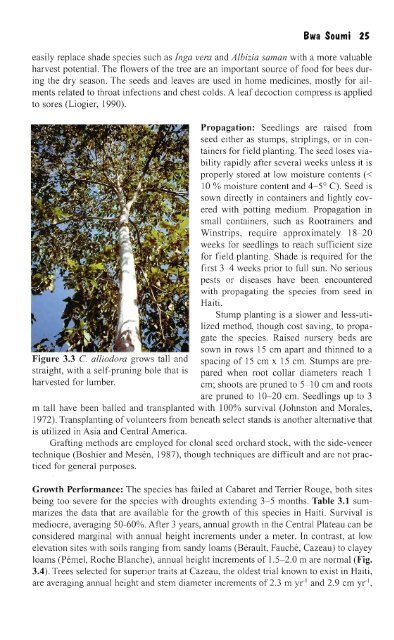Bwa-yo - Société Audubon Haiti
Bwa-yo - Société Audubon Haiti
Bwa-yo - Société Audubon Haiti
You also want an ePaper? Increase the reach of your titles
YUMPU automatically turns print PDFs into web optimized ePapers that Google loves.
Figure 3.3 C. alliodora grows tall and<br />
straight, with a self-pruning bole that is<br />
harvested for lumber.<br />
<strong>Bwa</strong> Soumi 25<br />
easily replace shade species such as Inga vera and Albizia saman with a more valuable<br />
harvest potential. The flowers of the tree are an important source of food for bees during<br />
the dry season. The seeds and leaves are used in home medicines, mostly for ailments<br />
related to throat infections and chest colds. A leaf decoction compress is applied<br />
to sores (Liogier, 1990).<br />
Propagation: Seedlings are raised from<br />
seed either as stumps, striplings, or in containers<br />
for field planting. The seed loses viability<br />
rapidly after several weeks unless it is<br />
properly stored at low moisture contents «<br />
10 % moisture content and 4-5 0 C). Seed is<br />
sown directly in containers and lightly covered<br />
with potting medium. Propagation in<br />
small containers, such as Rootrainers and<br />
Winstrips, require approximately 18-20<br />
weeks for seedlings to reach sufficient size<br />
for field planting. Shade is required for the<br />
first 3--4 weeks prior to full sun. No serious<br />
pests or diseases have been encountered<br />
with propagating the species from seed in<br />
<strong>Haiti</strong>.<br />
Stump planting is a slower and less-utilized<br />
method, though cost saving, to propagate<br />
the species. Raised nursery beds are<br />
sown in rows 15 cm apart and thinned to a<br />
spacing of 15 cm x 15 cm. Stumps are prepared<br />
when root collar diameters reach 1<br />
cm; shoots are pruned to 5-10 cm and roots<br />
are pruned to 10-20 cm. Seedlings up to 3<br />
m tall have been balled and transplanted with 100% survival (Johnston and Morales,<br />
1972). Transplanting of volunteers from beneath select stands is another alternative that<br />
is utilized in Asia and Central America.<br />
Grafting methods are employed for clonal seed orchard stock:, with the side-veneer<br />
technique (Boshier and Mesen, 1987), though techniques are difficult and are not practiced<br />
for general purposes.<br />
Growth Performance: The species has failed at Cabaret and Terrier Rouge, both sites<br />
being too severe for the species with droughts extending 3-5 months. Table 3.1 summarizes<br />
the data that are available for the growth of this species in <strong>Haiti</strong>. Survival is<br />
mediocre, averaging 50-60%. After 3 years, annual growth in the Central Plateau can be<br />
considered marginal with annual height increments under a meter. In contrast, at low<br />
elevation sites with soils ranging from sandy loams (Berault, Fauche, Cazeau) to clayey<br />
loams (Pemel, Roche Blanche), annual height increments of 1.5-2.0 m are normal (Fig.<br />
3.4). Trees selected for superior traits at Cazeau, the oldest trial known to exist in <strong>Haiti</strong>,<br />
are averaging annual height and stem diameter increments of 2.3 m yr- I and 2.9 cm yr- I ,



